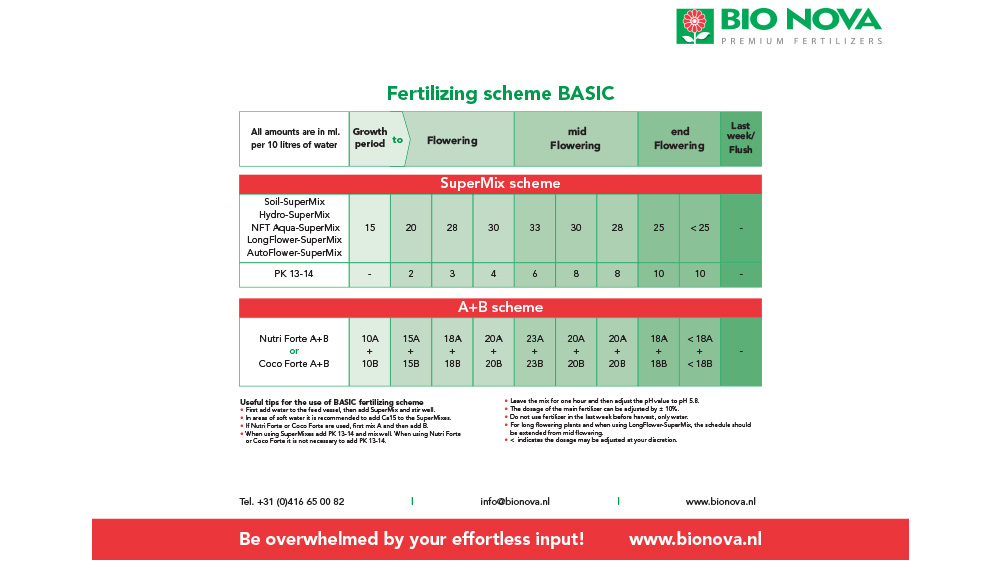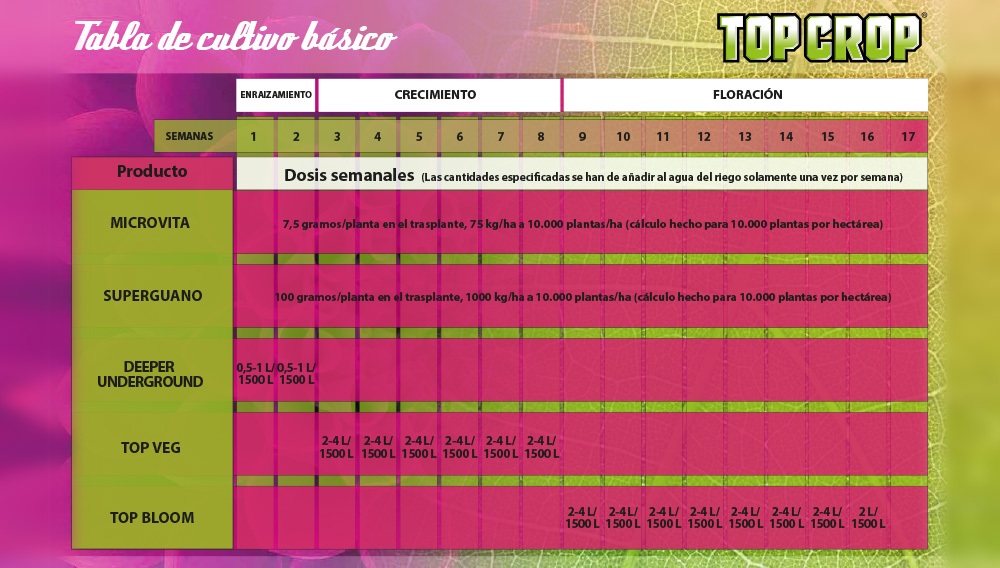
The tables created by the different nutrient brands are aimed at inform the user about what products of your brand can you mix, in what measures or doses and how often they should be applied. Remember that these data are only indicative and they should not be taken as a sole reference. There are thousands of different genetics, and within each genetics each plant is different and they do not have to react the same to the same doses. From Gea Seeds we recommend be adequately informed of the needs of your crop, give the plant only what it needs and do not rely solely on the boards.
grow tables
How to interpret the tables?
1-Culture medium: The tables usually include what type of crop it is designed for (Earth, Coco, Hydroponics …)Therefore, before following the indications we have to locate which one corresponds to our cultivation system.
2-Compatibility between different products: The next step will be recognize fertilizers to be used, they should all be compatible and from the same brand. How do you know if they are compatible? Very simple, if different fertilizers are in the same table Compost means that they can be combined.
3-Identify the week or stage and adapt: Most brands plan on their tables 2 weeks of growth and about 8 of flowering. But the reality may be quite different. In the case of crops with cuttings, the period of 2 weeks of growth may be true, but .. What if we plant from seed? What if the plant is outside and there are still weeks to start the flora? What if the genetics I grow need more than 8 weeks of flora? What if you need less?
In these cases we should put the table aside and give the plant what it needs. For example, if you start from seed, we recommend from Gea Seeds only use rooters during the first two weeks. During this period the plants do not need much food, which they can obtain from the same substrate, and an excess could overfertilize and seriously damage them. Or on the contrary, if our plant still has weeks of growth but the table tells me to start with the flora nutrients, the ideal would be to ignore it, continue with growth only if the same plants ask you to do so and once the flowering approaches, take the table where you left off.
4- Characteristics of genetics: Each variety is different, some will flower in 12 weeks and others in just 6. Some will need a lot of food during growth and others will have plenty of food that incorporates the substrate. As we have already commented, identify what type of plant you have and do not strictly follow the cultivation schemes if the times do not correspond.
5- Dosage or quantities of product: Most ideal dosage charts are found expressed in ml / l (ml of product per liter of water), although Is not always that way and you should be careful in case another unit of measure is used. From Gea we recommend decrease the quantities by 10-20% indicated in the table to avoid overfertilization problems.
6- Water quality, Ec and pH: Not all waters are the same some will be harder and others softer. Remember to always regulate the parameters of Ec y pH adjusting them to the data indicated in the corresponding table. Normally you will have to maintain the pH levels between 5.5 and 6.5 and the levels of Ec (Electro-conductivity) depending on the cultivation system and vital phase of the plants.
7- Common sense: Plants are not robots or mechanized units that always have the same needs. With experience and common sense you should adjust the indicated doses by the manufacturer to the needs of your crop. Let’s take an example, your plants are beginning to suffer symptoms of over-fertilization, however, the diagram-table that you are following indicates that today it is time to irrigate with fertilizer. As much as the table says, common sense tells us that the plant cannot absorb everything what I’m putting on it and I should slow down or the doses and even skip them.
Atami

table atami earth
It has a multitude of tables that show the correct use of all its products. Depending on the cultivation system You will have to use some products or others in particular and with their specific doses. The above diagram shows us the use of its ATA range on Earth substrates.
B.A.C.

table bac organic farming
Prestigious brand with More than 15 years of experience based in Holland and known all over the world. Their cultivation schemes are very simple and easy to follow. First you will have to select the correct table depending on the type of food if it is organic or mineral. Once you have identified the table, look for the products you have, their doses and application times. Remember that it is not necessary to have all the nutrients that appear in the schematic. To take into account, unlike others in this table other ideal values are marked such as pH, Ec, humidity, Temperature, fan speed…. We recommend being the most faithful to these values for assured success.
Bio Nova

bionova table basic cultivation
Well-known brand with dozens of products and almost 30 years of experience (early 90s) that is committed to innovation and development. Although they have 5 different schemes, we have represented the most basic and used where you will find what you need. This table, the basic, includes its most used products, both from the SuperMix range and the Nutri / Coco Forte A + B components. Regarding the unit of measurement, all the data are indicated in ml per 10 liters, and the ‘<' symbol must be taken into account, indicating that the dose is not exact and must be adjusted according to the user, always putting less than indicated.
Grotek

grotek solo-tek deck
Quality biomineral nutrients with more than 20 years of development in the market. Originally from Canada, Grotek is used every time in Spain. Their tables are divided into two groups, first according to the type of cultivation (soil or hydroponic) and these groups are divided in turn depending on the phase (growth or flowering). In the previous representation you can find the most used and complete of the brand. Although the Grotek tables are very easy to interpret, it must be borne in mind that the amounts shown are weekly. Therefore, if you do more than one watering a week, you must divide that amount or combine waterings without food.
Hesi

hesi floor board
Caution: The tables express the ideal doses using ml / 10 L, (milliliters of product for every 10 liters of irrigation) and not for every liter. Although the amounts are defined for all the brand’s fertilizers, remember that it is not mandatory to use all that appear. Hesi’s growing plans are defined by the type of substrate used. We found 3 different schemes depending on the medium used soil, coconut and hydroponics. In the previous photo you can find the floor with the most used products.
Plagron

tabla plagron terra
Another brand of Dutch origin with years of experience and dozens of different products. To know how to use Plagron fertilizers correctly we will have to look at 4 different tables and choose the one that corresponds to our cultivation system. There are schemes for crops using only products natural, another for growers in substrate of Earth, another for substrates of coco and finally, for hydroponic. The measure used is ml for every 10 liters of water, and like most, it begins when the plant is a week or more old or the cutting is already rooted and beginning to grow. All are developed calculating 9 weeks of flowering, remember to adjust it to your needs in shorter flowering varieties.
Top Crop

basic topcrop table
It has 2 different cultivation schemes depending on the number and type of products used. The 2 tables are: for staple crops (with commodities), for professional crops (the most sugary basic products like Top Candy, or preventives like Barrier). You have to be careful when interpreting them since they have quite a few differences compared to boards from other brands. The Top Crop tables are based on crops from seed and outdoor, that is why the rooting phase is included (the first two weeks of the plant), and the growth phase is extended to 8 weeks and not 2 like the other brands. Another detail to take into account is that they do not include a last week of irrigation with only water, something that we recommend from Gea Seeds to clean the excess food.
Trabe

table beam fertilizers
Trabe’s organic fertilizer plan is very easy to interpret and follow. They only have a table where they indicate the doses of all their products and the times to follow. Like most, it has been calculated based on growing with cuttings. Remember that if you plant from seed, week 1 of the table does not correspond to the first week of the seed’s life. That week of growth will begin to count when the seed reaches a size and structure similar to cuttings, usually a week and a half from germination. The measurements in this case are ml per liter per week. Therefore, if your crop needs more than one watering a week, you should divide the recommended amount between the different waterings or alternate them with water just to avoid excesses.
The entry CULTIVATION TABLES: BIO NOVA, PLAGRON, TOP CROP, TRABE… appears first on GeaSeeds Cannabis Blog.








